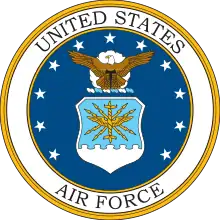586th Flight Test Squadron
The 586th Flight Test Squadron is part of the 96th Test Wing based at Holloman Air Force Base, New Mexico.
586th Flight Test Squadron
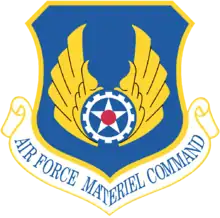 | |
|---|---|
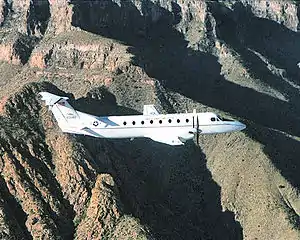 586th Flight Test Squadron C-12J Huron | |
| Active | 1943-1946; 1982-present |
| Country | |
| Branch | |
| Role | Flight Test |
| Part of | Air Force Material Command |
| Garrison/HQ | Holloman Air Force Base |
| Engagements | European Theater of Operations[1] |
| Decorations | Distinguished Unit Citation Air Force Outstanding Unit Award French Croix de Guerre w/ Palm[1] |
| Insignia | |
| 586th Flight Test Squadron emblem (approved 26 January 1996)[1] |  |
| 6586th Test Squadron emblem (approved 8 December 1983)[2] |  |
| 586th Bombardment Squadron emblem (approved 29 June 1943)[3] | 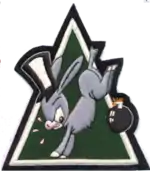 |
Mission
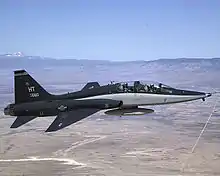
The 586th Flight Test Squadron plans, analyzes, coordinates and conducts flight tests of advanced weapons and avionics systems primarily on the White Sands Missile Range.
It provides deployable operational support for test aircraft staging out of Holloman AFB. The squadron flight tests guidance systems, laser systems, air-to-air/air-to-ground systems, long-range and standoff weapons, live warheads, and provides target and photo/safety chase.
The 586th operates three AT-38B aircraft. These aircraft are modified for test, test support, target, and photo/safety chase. Capabilities of the squadron's AT-38B's include: chaff, flares, Global Positioning System (GPS) navigation and precision data recording and telemetry, electronic counter- measures (ECM), towed target, threat and cruise missile simulation, Air Combat Maneuvering Instrumentation pods, and multiple format photographic coverage (including helmet-mounted video cameras). They are equipped with an internal Fighter Instrumentation and Navigation System which relies on inertial navigation and global positioning inputs to develop a reference for time-space-position information. Each aircraft has a 200-ft AGL capability utilizing radar altimeters and moving map displays. For specialized tests, customer provided test equipment may be rack mounted and installed in place of the rear ejection seat or externally in a pod.
Externally, the aircraft has a modified centerline pylon to enable carriage of many types of test and operational stores such as the ALQ-167 Electronic Counter Measures (ECM) pod, which is programmable with a wide variety of electronic jamming techniques as well as an ALE-40 chaff and flare pod. External stores can be provided with AC and DC power. Another test capability under development is a Low Observable Instrumented Tow Target system that will support many different types of tests. Flight cleared pods are available for carriage of additional customer defined stores.
History
World War II

Formed under III Bomber Command in early 1943 as a Martin B-26 Marauder medium bomber squadron. Trained for duty in Europe with Ninth Air Force. Engaged in combat beginning in early 1944, attacked tactical targets in France, Low Countries and Germany supporting Allied ground forces advancing after D-Day in Northern France Campaign and the Western Allied invasion of Germany, 1945. Received Douglas A-26 Invaders in April 1945, however did not use in combat. After V-E Day, was part of the Army of Occupation in Germany and inactivated in early 1946.
Test operations
It has provided operational and maintenance support for all Department of Defense test aircraft staging out of Holloman Air Force Base from, 1982–1990. The squadron flew developmental test and evaluation missions and has supported DOD test flights on White Sands Missile Range since 1991.[1]
Lineage
586th Bombardment Squadron
- Constituted as the 586th Bombardment Squadron (Medium) on 15 February 1943
- Activated on 5 March 1943
- Redesignated 586th Bombardment Squadron, Medium on 9 October 1944
- Redesignated 586th Bombardment Squadron, Light on 3 December 1945
- Inactivated on 31 March 1946
- Consolidated with the 6586th Test Squadron on 1 October 1982[1]
586th Test Squadron
- Designated as the 6586th Test Squadron on 15 December 1982 and activated
- Consolidated with the 586th Bombardment Squadron and redesignated 586th Test Squadron on 1 October 1992
- Redesignated 586th Flight Test Squadron on 15 March 1994[1]
Assignments
- 394th Bombardment Group, 5 March 1943 - 31 March 1946
- 6585th Test Group (later 46th Test Group), 15 December 1982
- 96th Test Group, 1 October 2012 – present[1]
Stations
- MacDill Field, Florida, 5 March 1943
- Ardmore Army Air Field, Oklahoma, 12 July 1943
- Kellogg Field, Michigan, 19 August 1943 – 15 February 1944
- RAF Boreham (AAF-161),[4] England c. 11 March 1944
- RAF Holmsley South (AAF-455),[4] England, 24 July 1944
- Tour-en-Bessin Airfield (A-13),[5] France, 25 August 1944
- Orleans/Bricy Airfield (A-50),[5] France, 18 September 1944
- Cambrai/Niergnies Airfield (A-74),[5] France, 8 October 1944
- Venlo Airfield (Y-55),[5] Netherlands, 2 May 1945
- AAF Station Kitzingen, Germany, September 1945 – 15 February 1946
- Holloman Air Force Base, New Mexico, 15 Dec 1982–Present[6]
Aircraft
- Martin B-26 Marauder, 1943-1945
- Douglas A-26 Invader, 1945-1946
- Nortrop AT-38 Talon, 1991–present
- Beechcraft C-12 Huron, 1997–present[1]
References
Notes
- Explanatory notes
- This aircraft was shot down by anti-aircraft artillery Mar 22, 1945. Missing Aircrew Report (MACR) 13040
- Citations
- Robertson, Patsy (4 September 2008). "Factsheet 586 Flight Test Squadron (AFMC)". Air Force Historical Research Agency. Retrieved 6 May 2014.
- Endicott, p. 874
- Maurer, Combat Squadrons, p. 674
- Station number in Anderson.
- Station number in Johnson.
- Station information in Robertson, except as noted.
Bibliography
![]() This article incorporates public domain material from the Air Force Historical Research Agency website http://www.afhra.af.mil/.
This article incorporates public domain material from the Air Force Historical Research Agency website http://www.afhra.af.mil/.
- Anderson, Capt. Barry (1985). Army Air Forces Stations: A Guide to the Stations Where U.S. Army Air Forces Personnel Served in the United Kingdom During World War II (PDF). Maxwell AFB, AL: Research Division, USAF Historical Research Center. Archived from the original (PDF) on 4 March 2016. Retrieved 7 July 2012.
- Endicott, Judy G. (1998). Active Air Force Wings as of 1 October 1995 and USAF Active Flying, Space, and Missile Squadrons as of 1 October 1995 (PDF). Air Force History and Museums Program. Washington, DC: Office of Air Force History. ASIN B000113MB2. Retrieved 2 July 2014.
- Johnson, 1st Lt. David C. (1988). U.S. Army Air Forces Continental Airfields (ETO) D-Day to V-E Day (PDF). Maxwell AFB, AL: Research Division, USAF Historical Research Center. Archived from the original (PDF) on 29 September 2015.
- Maurer, Maurer, ed. (1983) [1961]. Air Force Combat Units of World War II (PDF) (reprint ed.). Washington, DC: Office of Air Force History. ISBN 0-912799-02-1. LCCN 61060979. Retrieved 17 December 2016.
- Maurer, Maurer, ed. (1982) [1969]. Combat Squadrons of the Air Force, World War II (PDF) (reprint ed.). Washington, DC: Office of Air Force History. ISBN 0-405-12194-6. LCCN 70605402. OCLC 72556. Retrieved 17 December 2016.

